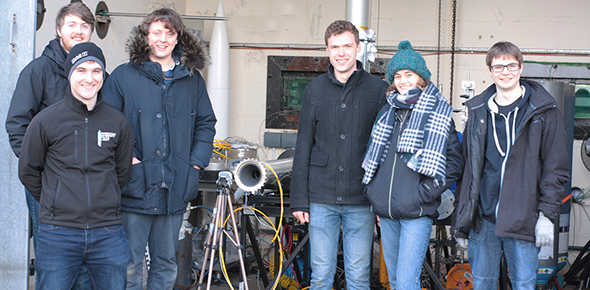A rocket engine designed and built by a Cambridge student society has produced, what is believed to be, the largest impulse of any nitrous hybrid rocket ever fired in the UK.
To the best of our knowledge and those in the industry who we have asked to confirm, our Pulsar hybrid rocket engine has the largest impulse of any nitrous hybrid ever fired in the UK.
Undergraduate Matt Escott
Cambridge University Spaceflight (CUSF) carried out a static test of their custom Pulsar hybrid rocket engine at Airborne Engineering Ltd’s test facility recently. It produced a measured impulse of 53,855 newton seconds. The Pulsar engine burned nitrous oxide combined with high-density polyethylene fuel to produce thrust for a total of 36 seconds.
CUSF membership is a mix of undergraduates and PhD students. It aims to put students’ theoretical knowledge to work in practical applications, providing opportunities to work on complex multidisciplinary projects in the fields of high power rocketry and high altitude balloons.
Matt Escott, CUSF member and Engineering undergraduate, said: "Whilst working on a number of projects simultaneously at any one time, CUSF is working towards the long-term goal of breaking the European amateur rocketry altitude record, and the team believes that the recent Pulsar engine test represents a major milestone on this journey. To the best of our knowledge and those in the industry who we have asked to confirm, our Pulsar hybrid rocket engine has the largest impulse of any nitrous hybrid ever fired in the UK.
"We are extremely grateful to Airborne Engineering Ltd (and the many CUSF alumni who work there) for letting us use their fantastic rocket test facilities and giving up their time to help us. The test captured a huge amount of data and the team are hard at work trying to analyse it in order to learn as much as possible about the Pulsar engine."
The Pulsar project follows the launch of CUSF’s Martlet 3 rocket in Nevada in 2017. The Martlet 3 was designed to break the UK Amateur Rocketry Altitude record, but was destroyed in flight when the commercial off-the-shelf rocket motor exploded. This inspired CUSF to try and build something better, resulting in the Pulsar engine that they designed and built from scratch in 18 months. The Pulsar engine is intended to power CUSF’s Martlet 4 rocket project, set to launch in 2020.
To get involved with CUSF, email contact@cusf.co.uk

CUSF team members present at the firing of the rocket, from left, Matt Coates, Matt Escott, Jack Brewster, Matt Pengelly, Annabelle York, Joe Hunt. Credit: CUSF alumnus Adam Greig.

